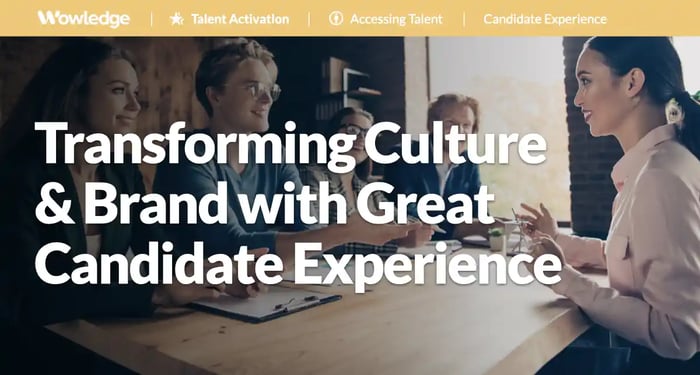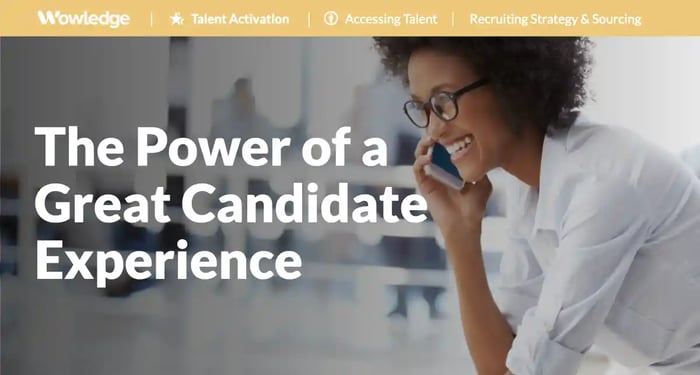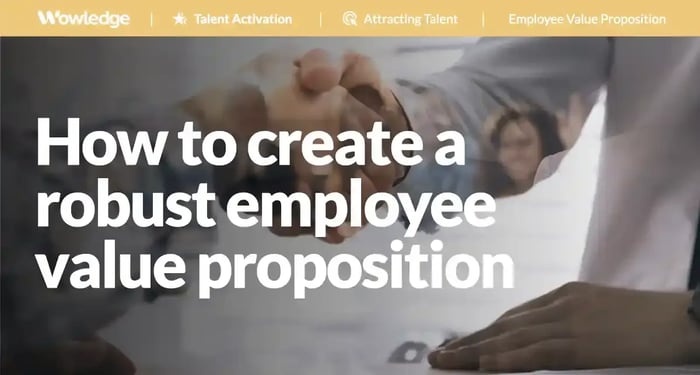Table of Contents
- The reasons why promoting an employer brand is essential
- Understanding an employer brand
- The relationship between employer brand and EVP
- The benefits of employer branding strategies
- Steps to take to build more effective employer branding strategies
- The importance of social media
- A final note on optimizing employer branding strategies
- Relevant Practices & Tools
- About Wowledge
As employers of all sizes and industries worldwide face talent shortages, the challenges for their recruiting teams are immense. Even with the advancement of talent acquisition technologies, which enable the replacement of lower-level recruiters and administrators, successfully attracting sufficiently large pools of applicants remains a major barrier. Those jobs being replaced were largely responsible for administering, screening, and supporting the selection of new hire candidates; talent attraction occurs long before these steps in the recruiting lifecycle. Enter employer branding strategies as an element that requires significant ongoing attention by recruiting and HR teams. These communicate and influence a company’s reputation by promoting what makes it a great place to work, grow, advance, and earn a living.
The reasons why promoting an employer brand is essential
Why are employer branding strategies so critical to recruiting success? A wealth of evidence supports the notion that job seekers use a company’s reputation as an employer before 1) applying, 2) accepting an interview invitation, and 3) accepting a job offer. 91% of job-seekers search online ratings before applying for a job, while only 21% of candidates stated that they would apply to a 1-star rated (out of 5) company, and 34% to one with a 2-star rating.
Research has found that 6 out of 10 applicants choose a job based on the extent to which a company’s values match their own. Furthermore, Glassdoor reported that 86% of women and 67% of men in the United States will not accept a job from a company with a bad reputation, and 50% of candidates say they will not do so even for a pay increase.
The facts support the notion that having a trusted and admired reputation communicated through employer branding strategies is a must-have in today’s highly competitive labor markets. And yet, only 28% of organizations report having a consistently applied and comprehensive employer branding strategy in place. The key is to understand what constitutes an employer brand, and then assess, upgrade, and promote it to attract a larger volume of suitably qualified candidates for job openings.
Understanding an employer brand
An employer brand represents an organization’s reputation, or how it is perceived by those directly operating within its boundaries. It is like a living, breathing organism, as it is prone to growth and improvement, regression, and shifts based on the individual experiencing it in a given moment. It encompasses the company culture, predominant leadership style, mission, values, and beliefs, as well as the prevailing views of these aspects held by employees, candidates, partners, and suppliers. Their opinions and perceptions form what attracts candidates, customers, partners, and press attention.
Talent attraction has moved beyond postings on company career sites and commercial and professional job boards. Employer brand strategies are marketing efforts that require continuous activity, updating, targeting (and retargeting), and refreshing to capture the attention and imagination of potential job seekers. Employer brand strategies engage qualified candidates by promoting what the organization offers that is attractive and exciting to prospective new hires.
An employer brand encompasses several key elements, primarily driven by its business reputation, what makes it a special employer, and how the public and market perceive the company. It is defined in large part by its employer value proposition (EVP), or the elements that differentiate the benefits and experience of employment with the organization. As such, it considers the company’s mission, workflows and processes, working environment, management practices, pay and benefits, and community positioning. However, it is determined by how employees and other stakeholders experience those and then share those with outsiders via social media communications, reviews, posts, testimonials, and employment referrals.

The relationship between employer brand and EVP
An important distinction needs to be made between the employer brand and a company’s employee value proposition (EVP). An EVP represents the real and implied promises that a company makes to its employees in exchange for their agreement to utilize their skills and efforts in contributing to the company's objectives. It encompasses culture, skill development, career progression, work location and scheduling options, work-life balance, rewards, and recognition. It flows from, and should align well with, the company's mission, values, strategic directions, and objectives.
The employer brand is the company's reputation, as created, promoted, and communicated through various means to interested stakeholders. The content of employer branding strategies comes from the elements of its EVP that are attractive to and sought by job candidates. Understanding these elements is essential to effectively market a company’s career opportunities to prospective new hires, which involves a combination of HR programs and hiring manager practices. Examples of the elements of an EVP that a brand can communicate and promote include:
- Competitive pay
- Robust welfare, savings, time-off, and related benefits
- Positive culture and welcoming environment
- Supportive management and guidance
- Meaningful work and experiences
- Career growth and advancement opportunities
- Updated tools and useful resources
- Streamlined (work and administrative) processes, systems, interactions
The benefits of employer branding strategies
Companies that excel in employer branding achieve superior results in several key talent and business outcomes. Having a great EVP that is consistently promoted and updated has been demonstrated to attract more and better job candidates. In fact, LinkedIn found that small to medium-sized businesses with robust employer branding strategies enjoy 50% lower recruiting costs (CPH), 50% more qualified applicants, and 1-2 times faster time to fill open jobs. It is also found to lead to subsequently higher employee engagement and 28% higher retention rates due to the resulting pride of the employment relationship and aligned experiences among their new hires.
These are successful at differentiating companies from the competition, to the extent that research has shown that well-branded organizations report significantly higher employee engagement rates (71% vs 20%) and employee retention levels (67% vs. 22%) than those with weaker brands. Further data support the notion that reputation is a key factor in being a preferred employer, extending to a company’s reputation in the marketplace, with findings indicating that 64% of consumers have stopped purchasing a brand after hearing news of that company’s poor employee treatment.

Steps to take to build more effective employer branding strategies
An employer brand is not created; it already exists in the minds of current and former employees, as well as job candidates. The goal of a branding effort is to turn it into an ongoing strategy that is actively managed, updated, and curated. The challenge is making employer branding strategies that drive a positive impression on everyone who encounters the company as an employer. Three key leading practice steps can create robust employer branding strategies that deliver more suitably qualified candidates for open jobs: identify, manage, and promote the brand.
1. Identify the brand
The starting point is to define what makes the company an attractive and valuable place to work, from the perspective of its employees. A common misstep that many organizations make is having their management or recruiting teams define it in terms of what they think makes it an attractive place to work. The alternative is to ask those who are employed about what it is like to work and engage with the organization and its people on a daily and ongoing basis.
Consolidate existing employee listening efforts with new methods to generate an understanding of their opinions about what they value the most and have the most positive impressions about their employment with the organization. Review data from engagement and pulse surveys, exit interviews, and conduct employee focus groups to get insights on their satisfaction (or otherwise) with any topic related to their work, how they are managed, their growth and development opportunities, and their benefits.
Analyze the combined data and insights to develop a comprehensive view of the employment experience related to the people (coworkers and management), practice (management and supervision received, feedback and coaching, skill development), policy (pay and benefits, workplace and schedule, paid leave), process (hiring, onboarding, performance evaluation, job mobility), and platform (systems related to payroll and benefits, learning management, career development and advancement opportunities).
Review the data by employee demographics, with special attention paid to the groupings of employees who are most valued—those who are longer-tenured, with multiple promotions, consistently higher performance ratings, as well as those in critical skill roles. The key is to understand what the elements of their worklives are reported as making it a great place to work. Use that to craft an EVP statement(s) that can be used for targeted communications and follow-up, with a focus on what differentiates employment with the company from that of competitors.
2. Manage the brand
The “heavy lifting” comes in managing the identified brand as a living, evolving organization that represents stakeholder employee sentiment as the organization grows, expands its market and geographic presence, and adapts to shifts in the external (economic and labor markets) environment. This requires a proactive and continuing effort to understand what differentiates the culture and work environment across every stage of employment.
Three key elements of managing the brand are utilized to drive the effectiveness of employer branding strategies:
- Focusing on the employee and candidate experience: The critical aspect of managing employer branding strategies is to attend to the employee experience, which drives the EVP and brand reputation. Start with design thinking methodologies by mapping the employee journey from candidate to alumnus, getting employee insights on the interactions they have (with people, processes, technologies) that most influence their perceptions of the quality of their employment relationship (known as “moments that matter”), and using those insights to continuously improve those. Consider every major step in the journey, including:
— Candidate experience
— Onboarding
— Skill and experiential development
— Performance coaching and evaluation
— Total compensation practices and processes
— Career advancement and mobility
— Social, team, and culture-building events and contributions
— Retirement or departure
— Alumni or post-employment connection - Improving practices and processes to address the employment experience: Taking action on employee feedback and design suggestions is crucial to building a successful and attractive brand. Integrate the insights gained from this focus across all these touchpoints to ensure that employee preferences and pain points are consistently addressed. The value of these efforts in the employee experience is substantial when used to update, reengineer, and improve those critical practices, processes, and systems as needed. The benefits of an improved EVP and employee brand can only be achieved when the insights are used to address the issues that current employees and job candidates identify or perceive as problematic.
- Measuring the EVP and its outcomes: Exceptional employer branding strategies require ongoing measurement to audit, assess, and evolve them. The primary element is to understand the extent to which the brand that is communicated and promoted matches the actual employee experience. As social media collects and quickly disseminates the opinions of current and former workers, proactively managing any disconnects is critical. The use of advanced analytics to understand the perceptions and opinions of top performers, critical skills employees, high potentials (HIPOs), and leadership succession candidates will help guide improvements that enhance the attraction, hiring, and retention of the most valuable employees.
Assessing the impact of brand strength is a second consideration. The most valued outcomes of a solid EVP that evolves with the organization and its people are improved employment marketing, recruiting, and employee outcomes. Metrics to use as indicators include quality of hire (QoH), candidates per opening, offer acceptance rate, employee retention (both new hires and tenured employees), and candidate experience (CX) survey results. Social media analytics play a crucial role as indicators of the success of employer branding strategies, including candidate ratings, number of social media impressions and comments, career site visits, and application rates (or application submissions vs. job posting views).
3. Promote the brand
Communicating the brand means promoting what current and former employees find most compelling, whether it is the culture, great management, career advancement and development opportunities, the pay and benefits, or the collegiality of co-workers. The promotion and celebration of the brand should be shared with both candidates and employees.
Leading practice involves bringing it to life in three dimensions: 1) helping candidates experience the benefits (through testimonials, photo galleries, video snippets of a “day in the life”), 2) introduce new hires to the experience that the EVP promises (employee or avatar-guided facility tours, introductions to important people and resources), and 3) remind current employees about the promise and benefits they enjoy on a regular basis (presentations on new benefits or perks, total compensation statements).
Communications best leverages available HR technologies to send consistent, complete, and carefully crafted messages to all, while enabling tailoring for identified segments (specialized or critical roles, business units, or multi-national or geographic locations). Branding should be prominently promoted on the company's career site, with information such as the organization’s mission and vision, culture, values, and beliefs, social and community commitments, development opportunities and resources, pay and benefits, and policies that are reported by the most valued employees as key to their continued employment.
The applicant tracking system (ATS) should be utilized to actively promote and explain the employer brand in job postings, with the company's mission, values, and growth paths clearly stated. Additionally, links to relevant promotional content on the career site or elsewhere should be included in postings. Similarly, content in a candidate relationship management (CRM) system or module should be constantly updated with branding messages that include active job postings, company news, employee testimonials, and the latest innovations, business wins, big-name hires, and internal promotions, which can help convert passive candidates into active ones.
The use of current employees, such as tenured, articulate, and influential employees, as brand ambassadors is especially powerful in employer branding strategies. Glassdoor reported that employees are three times (3X) more credible than executives when describing working conditions. Ask employees from different levels, roles, and locations to give speeches and presentations, interviews, and write or contribute to articles on the career website, industry events, social media, recruiting collateral, and community events. Their communications can be especially powerful, trustworthy, and believable with both job candidates and current external messaging (utilized by TA, Marketing, and Investor Relations teams).

The importance of social media
The use of social media is crucial in developing and managing employer branding strategies. Postings are viewed by a majority of job seekers before applying, especially those Millennial and Gen Z individuals who now dominate the workforce. Active management of posts and content matters as well, with Glassdoor reporting that 70% of job seekers changed their minds about an employer after reading its response to negative employee or candidate reviews. It added that people are 75% more likely to apply to a job opening if they see the company actively responding to reviews, sharing updates on their work environment, and renewing its profile.
Research by CareerArc provides further support for the importance of actively managing employer branding messages and content across social media sites, as 63% of job seekers visit multiple online locations for information after learning about a job opening. This means that the company career site, LinkedIn (profile and postings), and employer review platforms all require consistent messaging and updates on an ongoing basis.
A final note on optimizing employer branding strategies
Articulating an EVP and creating a robust branding strategy and approach only go as far as the product they both are describing—the authentic employee experience. An organization cannot successfully attract and retain a workforce of highly skilled and productive workers if the brand does not represent reality. Business and HR leaders need to create and manage work environments where people are treated well, with constructive guidance, coaching, development, and respect. Corporate governance must prioritize the quality of employment on the same level as revenue, profitability, market presence, and customer loyalty.
This extends throughout the entire employee journey, from start to finish. Consider the impact of an inattention to, or creation of, a poor offboarding experience. 53.7% of online reviews of employers were negative, with ratings of one or two stars out of five. 52% of new hires who left within 12 months gave a 1-star review, and almost 12% of surveyed individuals reported lying or exaggerating to intentionally damage a former employer’s reputation or seek revenge against their former manager or coworkers.
Even worse, after going through the lengthy and often arduous process of applying, being screened, and interviewed, 31.3% of applicants reported turning down a job offer after reading online reviews from employers. The cost of a poor reputation and employer brand can be substantial and painful.
Relevant Practices & Tools
Core Recruiting Strategy and Sourcing Practices to Effectively Identify and Attract the Right Talent. >
Recruiting practices used to fill job positions effectively and efficiently have evolved significantly over the last decade, with several approaches being adopted... more »
Executing Effective Candidate Prospecting Campaigns to Fill Positions Successfully. >
Launching effective recruiting campaigns to target and attract highly aligned candidates for a job position requires structured practices as well as creativity and experimentation to continuously test and adapt... more »
Creating an Employee Experience that Bonds High Performers to the Organization. >
The employee experience constitutes the entire journey an employee takes with the organization. This includes everything from pre-hire to post-exit interactions and everything in between... more »
Using Human-Centered Design to Build Employee and Customer-Focused Innovation Initiatives. >
Human-centered design is an approach to innovation that grounds any initiative (service, program, or product) in real human needs by engaging the end-users in the design process... more »
The Communication Plan Template: Define, Structure, and Track Stakeholder Engagements for Successful Change Adoption. >
This template details the specific communications to drive individual and organizational change. The template will help organizations systematically define and track communications across all stakeholder groups... more »
About Wowledge
Wowledge is the implementation-first platform designed for lean HR teams and consultants who need to design and scale strategic HR programs efficiently—without starting from scratch.
Our members gain access to continuously updated best practices, step-by-step guidance, expert-built tools, and customizable templates—all structured to accelerate the development and implementation of key HR programs.
Recognizing that every organization operates at different levels of sophistication, Wowledge’s scalable system of best practices follows a stage-based approach—Core, Advanced, and Emerging—ensuring HR professionals can implement solutions tailored to their organization’s unique needs and goals.
Your Shortcut to Amplifying HR Impact!
Get started for FREE! Learn more.










